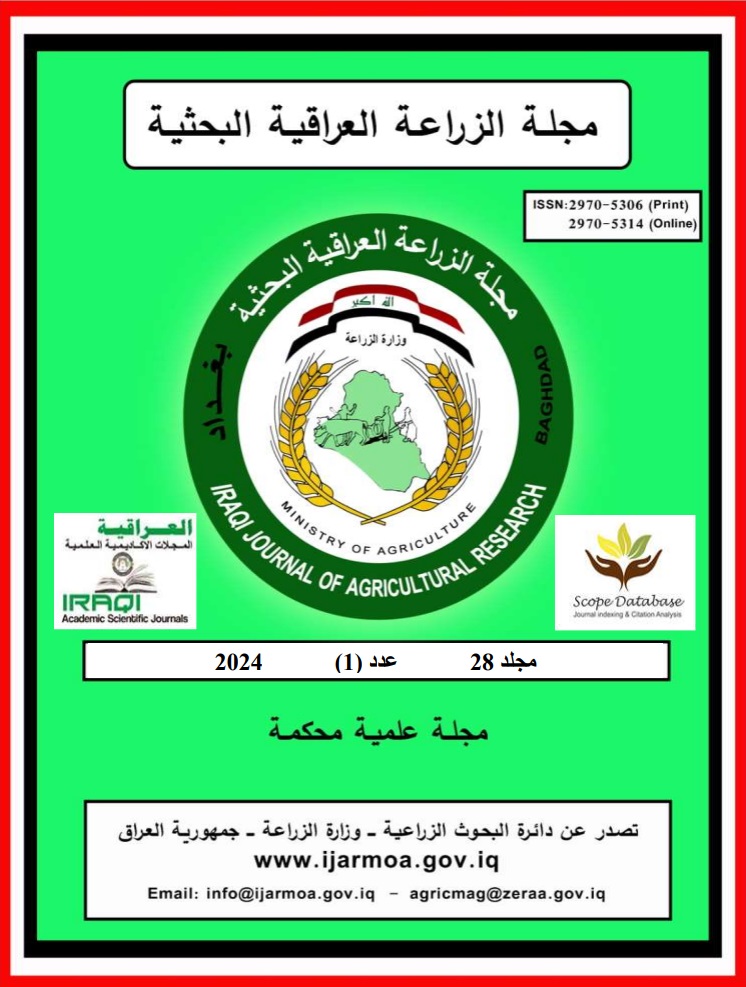Abstract
A field experiment was carried out during 2012 season at Field Crop Station, College of Agriculture, Tikrit University. The study included the effect of three levels of nitrogen fertilizer (0, 60 and 120 kg urea/ D) and 15 genotypes of upland cotton R.C.B.D. design by split plot arrangement with three replication, levels of nitrogen fertilizer were in main plots, whereas the in sub genotypes in sub plots. Data recorded for 11 traits: no. of days to 50% flowering, plant height, height of first fruiting branch, no of vegetative and fruiting branch, no of opened bolls, boll weight, and earliness percentage, gaining outturn, seed index and total seed cotton yield. The results showed significant differences between nitrogen levels for most traits except plant height, first fruiting branch, boll weight, earliness percentage and gaining outturn, otherwise the genotypes were significantly differed in all studied traits except no. of days to flowering. The genotypes Dierr22 showed surpassed others significantly for plant height, first fruiting branch and no. of fruiting branches traits , while the genotype (Coker310) was surpassed of opened bolls , gaining outturn and total seed cotton yield and the genotype (Lachata) was surpassed for boll weight and earliness percentage . The interaction between 0 level of N and Coker310 showed superiority for no. of opened bolls and gaining outtuen, and the 120 Kg with the same genotype for total of seed cotton yield, and the 60 Kg levels with Lachata genotype for boll weight. Environment, genotypic and phenotypic variances deviated from zero all traits and at all Nitrogen levels except for number of fruiting breaches in case of two variances, environmental and genotypic. Broad sense heritability was high for most traits and at three levels of Nitrogen, while the expeced genetic advance was high for no. of opened bolls, boll weight and seed cotton yield at the three level of Nitrogen.
Abstract
نفذت تجربة حقلية في الموسم 2012 في محطة أبحاث قسم المحاصيل الحقلية-كلية الزراعة- جامعة تكريت لدراسة تأثير ثلاثة مستويات من التسميد النتروجيني (0، 60 و120 كغم يوريا/دونم) وخمسة عشر تركيباً وراثياً من قطن الابلند، واستخدم تصميم القطاعات العشوائية الكاملة وفق نظام القطع المنشقة وبثلاثة مكررات، إذ احتوت مستويات التسميد النتروجيني الألواح الرئيسية والتراكيب الوراثيه الألواح الثانويه ، وسجلت البيانات عن احدى عشرة صفة هي: عدد الايام من تاريخ الزراعه لغاية تفتح 50% من الازهار وارتفاع النبات وارتفاع اول فرع ثمري وعدد الافرع الخضرية والثمرية وعدد الجوز المتفتح ومتوسط وزن الجوزة ومعامل التبكير وتصافي الحليج ودليل البذور وحاصل القطن الزهر الكلي، أظهرت النتائج أختلاف مستويات التسميد النتروجيني معنوياً لمعظم الصفات باستثناء ارتفاع النبات واول فرع ثمري ومتوسط وزن الجوزة ومعامل التبكير وتصافي الحليج، واختلاف التراكيب الوراثية معنوياً في الصفات المدروسة عدا صفة عدد الايام للازهار. سجل التركيب الوراثي دير22 تفوقاً معنوياً لصفات ارتفاع النبات وارتفاع أول فرع ثمري وعدد الأفرع الثمرية جميعها والتركيب كوكر310 لصفات عدد الجوز المتفتح وتصافي الحليج وحاصل القطن الزهر الكلي والتركيب لاشاتا لصفتي وزن الجوزة ومعامل التبكير . أظهرت حالة عدم استخدام السماد للتركيب الوراثي كوكر 310 تفوقاً ملحوظاً في صفتي عدد الجوز المتفتح وتصافي الحليج والمستوى 120 كغم سماد للتركيب الوراثي نفسه لصفة حاصل القطن الزهر والمستوى 60 كغم سماد والتركيب الوراثي لاشاتا لوزن الجوزة. أنحرفت التباينات البيئية والوراثية والمظهرية معنوياً عن الصفر للصفات ومستويات التسميد النتروجيني جميعها عدا صفة عدد الافرع الثمرية الخاصة بالتباين البيئي والوراثي، وكان التوريث بالمعنى الواسع (عالياً) لاغلب الصفات وللمستويات الثلاثة من التسميد، اما التحسين الوراثي المتوقع فكان عالياً لصفات عدد الجوزالمتفتح ومتوسط وزن الجوزة وحاصل القطن الزهر وللمستويات الثلاثة ايضاً.
